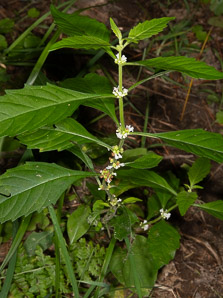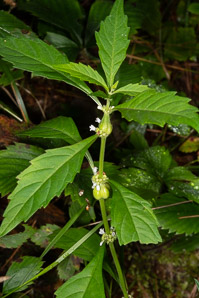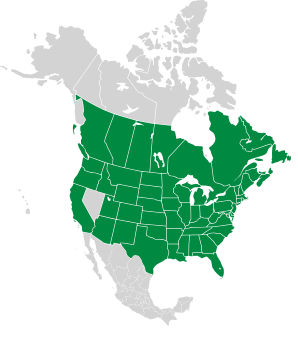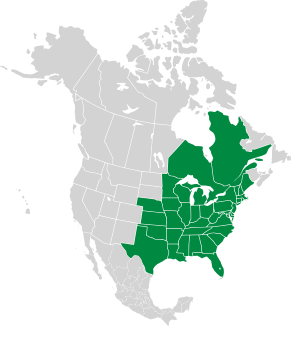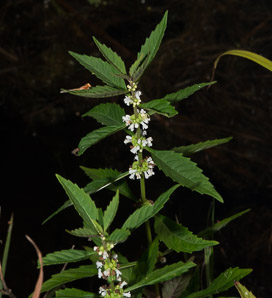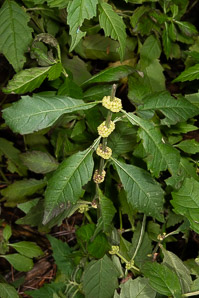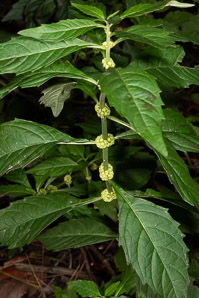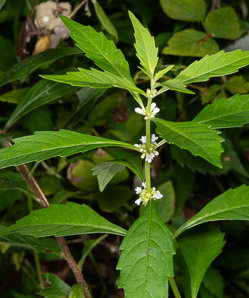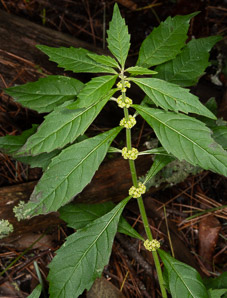
|
Lycopus uniflorus Michx. Northern bugleweed
Northern bugleweed is native to much of North America, and China, Japan, Korea, and the Russian Far East. The “bugle” in bugleweed comes from the bugle shape of the tiny flowers. (“Bugleweed” is also applied to some members of the Ajuga genus, such as Ajuga reptans). It is also called water horehound—from “hore,” downy, and “hune,” an old English word for a type of plant. It prefers wet areas such shores, swamps, marshes, wet meadows, and stream banks. Plants: 4-20″ (10-50 cm) tall, and usually straight or with a few branches. Stems are four-angled and almost hairless. Leaves: Up to 3″ (7.6 cm) long × 1″ (2.5 cm) wide. They are hairless or nearly so, with 2-7 teeth on each side of the leaf. The leaves are opposite, and each pair are rotated 90° from the previous pair. Flowers: Flowers occur in dense clusters at leaf axils. They are tubular, reaching in every direction from the leaf axil, and about ⅛″ (3.2 mm) around at the end. Fruits: Nutlets are 1/32-1/16″ (1-2 mm), in groups of four. Edibility: Roots are edible raw or cooked, in salads or soups, and were a common food source for indigenous peoples. Medical: Mildly sedative. Members of Lycopus, the water-horehounds, are notoriously hard to distinguish. They are also easily confused with some members of other genera. Here are some comparisons. |
8/22/2020 · Warbler’s Way, Moose Alley, Hidden Valley Nature Center, Jefferson, Maine · ≈ 4½ × 7″ (12 × 18 cm) Are those swollen nodes galls? · 8/31/2023 · Rines Forest, Cumblerland, Maine · ≈ 4 × 6″ (11 × 16 cm) |
||||||||||||||||||||||||||||
|
| |||||||||||||||||||||||||||||
Lycopus americanus |
You are here Lycopus uniflorus |
Lycopus virginicus |
|||||||||||||||||||||||||||
|---|---|---|---|---|---|---|---|---|---|---|---|---|---|---|---|---|---|---|---|---|---|---|---|---|---|---|---|---|---|
| Common Name |  |
 |
 |
||||||||||||||||||||||||||
| Plant | 1-3′ (30-91 cm) tall, unbranched or sparingly branched, sometimes sprawling. The main stem is four-angled and ridged, and hairless or nearly so. | 4-20″ (10-50 cm) tall, usually straight or with a few branches. Stems are four-angled and almost hairless. | 1-3′ (38-91 cm) tall, with an unbranched stem. It is erect, or sometimes leaning. Stems are roughly square in cross-section, and covered with fine hairs which may point outward or lie flat against the stem (appressed). These plants often (but not always) lack the thick tuberous roots of other water-horehounds. | ||||||||||||||||||||||||||
| Flowers | In small clusters at leaf axils. Individual flowers are ⅛″ (3.2 mm) in size, and white, with tiny purplish spots. They are tubular in shape, emerging in all directions from leaf axils. | Flowers occur in dense clusters at leaf axils. They are tubular, reaching in every direction from the leaf axil, and about ⅛″ (3.2 mm) around at the end. | Flowers appear in tight clusters at leaf axils. They are tubular in shape, and each is about ⅜″ (1 cm) long × ⅛″ (3.2 mm) in diameter. They emerge in all directions from the axil. Flowers are white, with a few pink spots. | ||||||||||||||||||||||||||
| Leaves | Lower leaves are deeply lobed, and up to 3½″ (8.9 cm) long × 1½″ (3.8 cm) wide. Leaves are narrowly oval, narrowly oblong, or linear. They are opposite, becoming smaller near the top, and coarsely toothed. Upper leaf surfaces are typically hairless. | Up to 3″ (7.6 cm) long × 1″ (2.5 cm) wide. They are hairless or nearly so, with 2-7 teeth on each side of the leaf. The leaves are opposite, and each pair are rotated 90° from the previous pair. | 1-4½″ (3-12 cm) × ⅜-1¾″ (1-5 cm). Oval or lanceolate, unlobed, with coarsely toothed edges. The lowest teeth are a little below the mid-point of each leaf. Leaves are more egg-shaped than those other water-horehounds. Leaves are dark green or purple, and opposite. Leaves nearer the bottom have a short stalk, while those near the top are attached almost directly to the stem. Upper leaf surfaces are nearly hairless, while lower surfaces have a hairy central vein and may have fine hairs elsewhere. | ||||||||||||||||||||||||||
| Fruit | Nutlets are in groups of four, together forming a square shape. Each is 1/32-1/16″ (1.2-1.7 mm) long. | Nutlets are 1/32-1/16″ (1-2 mm), in groups of four. | Each flower is replaced by four small nutlets, packed in roughly the shape of a square. Nutlets are 1/32-1/16″ (1.3-2 mm) × ~1/32″ (0.7-1.3 mm). | ||||||||||||||||||||||||||
| Range/ Zones |
|
|
|
||||||||||||||||||||||||||
| Habitats | Lake and river shores, and wetland edges. | Wet areas such shores, swamps, marshes, wet meadows, and stream banks. | River banks, floodplains, wet meadows, clearings, and shores. | ||||||||||||||||||||||||||
| Type | Wild | Wild | Wild | ||||||||||||||||||||||||||
| Occurrence | |||||||||||||||||||||||||||||
Leonurus cardiaca

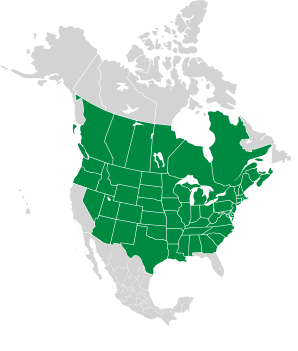
Online References:
Wildflowers of the United States
References:
Clemants, Steven; Gracie, Carol, Wildflowers in the Field and Forest, Oxford University Press, 2006, p. 342
8/28/2013 · Pearl Hill State Park, Townsend, Massachusetts · ≈ 7 × 10″ (16 × 25 cm) 
9/19/2023 · Denny Reed Trail, Phippsburg, Maine · ≈ 5 × 8″ (13 × 20 cm) 
9/19/2023 · Denny Reed Trail, Phippsburg, Maine · ≈ 5 × 8″ (13 × 20 cm) 
8/31/2023 · Rines Forest, Cumblerland, Maine · ≈ 4 × 6″ (11 × 16 cm) 
Lycopus uniflorus description by Thomas H. Kent, last updated 20 Sep 2023.
© FloraFinder.org. All rights reserved.
8/28/2013 · Pearl Hill State Park, Townsend, Massachusetts · ≈ 7 × 10″ (16 × 25 cm) 
9/19/2023 · Denny Reed Trail, Phippsburg, Maine · ≈ 5 × 8″ (13 × 20 cm) 
8/28/2013 · Pearl Hill State Park, Townsend, Massachusetts · ≈ 15 × 10″ (37 × 25 cm) 
Range: Zones 4-8:

